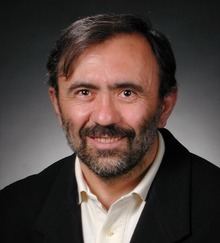Name Costas Soukoulis | Role Scientist | |
 | ||
Institutions University of AthensUniversity of ChicagoUniversity of VirginiaExxon Research LaboratoryAmes Laboratory - Iowa State UniversityIESL - Forth Research Center Doctoral advisor Kathryn Liebermann Levin Known for Photonic crystalRandom lasersMetamaterialsLight localization Books Wave Propagation: From Electrons to Photonic Crystals and Left-Handed Materials, Wave Propagation Institution National and Kapodistrian University of Athens, University of Chicago, University of Virginia | ||
Physics fom veldhoven 2013 costas soukoulis masterclass
Costas M. Soukoulis (Greek: Κώστας Μ. Σούκουλης) is a Senior Scientist in the Ames Laboratory and a Distinguished Professor of Physics at Iowa State University. He received his B.Sc. from University of Athens in 1974. He obtained his Ph.D. in Physics from the University of Chicago in 1978. From 1978 to 1981 he was at the Physics Department at University of Virginia. He spent 3 years (1981–84) at Exxon Research and Engineering Co. and since 1984 has been at Iowa State University (ISU) and Ames Laboratory. He has been an associated member of IESL-FORTH at Heraklion, Crete, Greece since 1984.
Contents
- Physics fom veldhoven 2013 costas soukoulis masterclass
- Costas soukoulis on photonic metamaterials
- Research
- Awards and honours
- References
Costas soukoulis on photonic metamaterials
Research
Soukoulis and his collaborators at Ames Lab/ISU in 1990 and 1994, suggested photonic crystal designs (lattice diamond and the woodpile structure, respectively), which gave the largest omnidirectional photonic band gaps. Many experimental groups all over the world still use his woodpile structure to fabricate photonic crystals at optical wavelengths, enhance the spontaneous emission and produce nanolasers with low threshold limit. Soukoulis and Wegener demonstrate magnetic responses and negative index of refraction at optical frequencies in metamaterials, which do not exist in natural materials. His other researches includes light and Anderson localization, random lasers, graphene and plasmonics.
